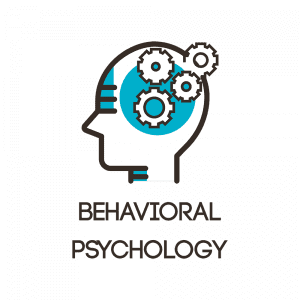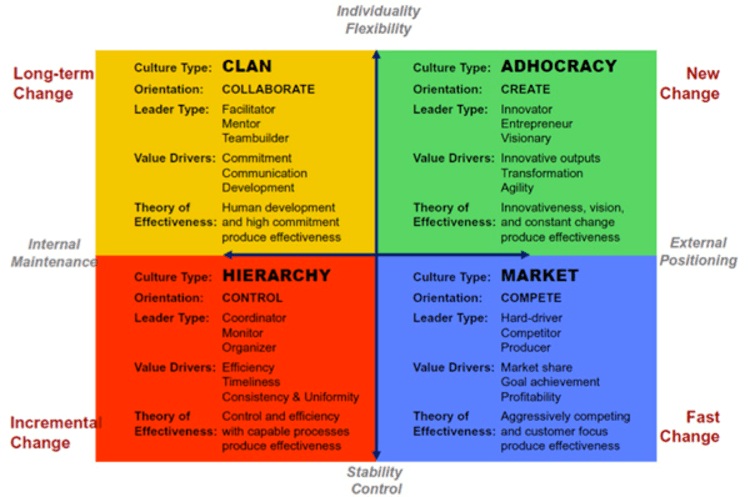October 5, 2017 |

Types Of Company Culture And Understanding Where Your Organization Fits
The effect of culture on an organization is profound, as it touches every aspect. It influences employees’ job satisfaction, the public’s perception and the organization’s bottom line. Therefore, your corporate culture should be flexible to growth in order to fit any changing needs. Each organization has a unique culture, but different cultures may have a set of similar characteristics that may place them in a similar category. Knowing organizational culture can help you understand your working environment. You can then match the culture to the company’s climate of operation. Some managers may not even be aware of their culture. The way they conduct their activities, treat employees, suppliers and customers, however, can give you a clue as to the type of culture they have. Using Quinn and Rorbaugh’s Competing Values Framework described here, you can classify the category in which the culture belongs.
Viewing Company Culture As A Variable Between Multiple Extremes
Company culture could be a company’s strongest quality or greatest liability. A culture that is difficult to imitate gives the organization a competitive advantage. Many business leaders even equate the importance of corporate culture to that of corporate strategy in the success of their business. The shared values within a company directly affect an organization’s performance in relation to revenues, market share, sales volume, and stock prices. Therefore, having the “most suitable” may be a competitive advantage, while having the “wrong” culture may negatively affect your company’s performance. It may even cause corporate failure, or it may hinder organizational change and the company’s risk-taking ability.
Organizational culture is also a powerful control mechanism that dictates employee conduct. It is more effective than rules and regulations in managing the behaviors of your workers. Creating a customer service culture, for instance, may encourage your employees to adopt a customer-oriented mentality, with the understanding that customer satisfaction is the most important factor.
Quinn And Rorbaugh’s Competing Values Framework For Defining Company Culture
Quinn and Rorbaugh came up with the concept of Competing Values Framework in judging effectiveness of organizations after conducting a series of empirical studies. They revealed that effectiveness comes in two dimensions; one relates to organizational focus, where an organization focuses internally on its workforce as well as the external focus on the organization itself. The other dimension is a contrast between two sets of variables: 1) flexibility and change and 2) stability and control.
The criteria used in the four models according to the Competing Values Framework, initially bear contradictory messages. This is because you want your company flexibility and adaptability for your company while also desiring stability and control.
The framework consists of four models: internal process, open systems, rational goal and human relations models.
The Internal Process Model (Hierarchy)
The basis of which is chain of command. It focuses on dimension, records and data management, processes that aim to bring stability and control.
The Open Systems Model (Adhocracy)
Rests on an organic system, and its focus is on processes that inspire people into creativity and innovation, such as readiness, adaptability, growth, external support and resource acquisition.
The Rational Goal Model (Market)
Focuses on profitability and rational action. This model functions on the premise that efficiency and productivity arise from proper goal setting and planning. You will explain tasks, set your goals and execute the strategy.
The Human Relations Model (Clan)
The basis of which is morale and cohesion. In this model, your organization emphasizes on human resource and development through training. Employees are not isolated individuals, but people who belong to a common social system who experience the effect of the outcome.
You can apply the Competing Values Framework in the context of your company as a strategic tool that you may use to create management and supervision programs, diagnose your corporate culture and examine organizational gaps. You may also utilize it as a teaching tool for your managers. The tool may enable you to comprehend various processes within your company. Lastly, you may use it to help your employees understand the contrasts in administrative leadership roles.
The Compass Of Organizational Culture
The 4-point axis graph shown below represents the specific types of cultures. Those in similar colors are related but conflicting in scope.
The Horizontal Spectrum Represents Inward Or Outward Organizational Focus
The horizontal dimension shows the degree in which a company focuses outward or inward. The attention toward the left is inward inside the organization; the focus toward the right is outward to the external environment, the suppliers and customers. An internal focus is ideal where you do not focus so much on the customer or competition. However, where external stakeholders are powerful, you must face the challenge directly. Each company will heavily focus on the internal influences on their business, their team development, their internal struggles, etc. or they will focus on external factors such as customer demands, market shifts and so on. Each organization sits somewhere on the spectrum.
The Vertical SpectrumRepresents The Difference Between BeingStable And Strict, Versus Fluid And flexible.
Each organization, again, will sit somewhere within the spectrum. The vertical axes have an influence on who the decision-makers are. The lower end is where the management is in control, while the upper end encompasses independent-minded employees who can make their own decisions. Stability is guaranteed when efficiency and reliability are the most important factors. However, flexibility becomes paramount when environmental forces necessitate transformation.
Using Position On These Two Axes To Characterize A Particular Type Of Company Culture
Clan Types Of Company Culture
The Clan culture places more emphasis on flexibility and less concern for control and structure. In this model, your company drives employees through shared goals, vision, outcomes and outputs instead of setting stringent rules and procedures. Compared to Hierarchies, clans are typically flat companies, which allow employees and teams greater autonomy. A clan focuses inward and provides an environment of teamwork and family, where people have strong loyal ties and a common cause. Rules and regulations still exist, but the company disseminates them socially. The leaders act supportively or assume a parental role. Maine, a company that makes all-natural hygiene products is an example of an organization that practices clan culture. The founder, Tom Chappell built the brand by focusing on building cordial relations with his suppliers, customers, employees, and the environment.
Adhocracy Types Of Corporate Culture
In an Adhocracy, the organization has greater flexibility than the Clan does. This degree of independence is necessary to enable your company to adapt to a volatile business climate. Market success may favor the fastest and easily adaptable organizations, but the adhocracy will enable the formation of teams to deal with new challenges. Prototyping and experimenting are the widely used methodology of activity instead of long projects and development that produce one major impact. Leaders in this model are innovative and visionary. They make significant gains by taking calculated risks. The social media giant, Facebook, exemplifies this culture. The company creates innovative products by trying unique products, even at the risk of failing, which is consistent with CEO Mark Zuckerberg’s adage, which encourages people to move speedily without fear of breaking things. If you do not break anything, you are moving too slowly. Facebook produces innovative products at a high rate, and its profitability is growing tremendously.
Hierarchy Types Of Organizational Culture
The structure and control of the Hierarchy leans towards a traditional approach. It flows from a strict chain of command evident in a bureaucracy. This was the typical organizational structure for most organizations in the past and persists in many others even today. The fact that such a structure gives respect for power and position makes it the most preferred choice for the majority of managers. Hierarchies usually have well-defined procedures, processes and policies. Most leaders who subscribe to this organizational culture are typically organizers and coordinators; they prefer to monitor proceedings very closely. Stereotypical bureaucratic organizations such as the military and McDonald’s come to mind when you mention this culture. The Department of Motor Vehicles may also qualify into this category.
Market Types Of Business Culture
The Market organizational culture is also a significant choice for managers who seek control. However, you would seek control by looking outward while being cautious about the transaction cost. You will not focus only on marketing, but also view every internal and external transaction in market terms. An effective market organization is one in which value flows between with the least delay and expense. Such organizations are often very competitive, result-driven and outward looking. Their leaders are often ruthless competitors who always seek to outdo others. Jack Welch and his company, General Electric, typify this culture. Welch’s topmost goal was to have every business unit of the company ranked first or second in its niche or else he would sell off the non-performing ones.
Final Words
This framework is useful to everyone including the employees, customers and even the management of companies. Potential employees can determine the type of culture in store for them if they want to join a company, while customers and suppliers will know the best way to approach the leaders in the company during a transaction.
Make a great first impression at your next job interview.
BROWSE OUR JOB BOARD TODAY!
This blog post is intended for informational purposes only and does not constitute legal advice. No attorney-client relationship is created between the author and reader of this blog post, and its content should not be relied upon as legal advice. Readers are urged to consult legal counsel when seeking legal advice.









